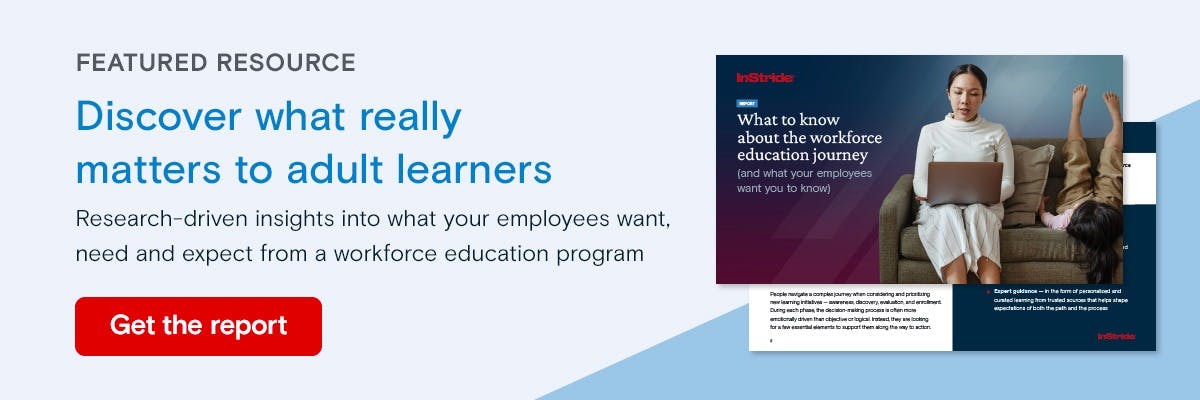Learning and development (L&D) is a core component of any effective talent management strategy. Employees require continuous development and learning to keep their knowledge and skills up-to-date throughout their time working at a company. L&D is also a powerful catalyst for developing leaders and building an internal talent pipeline for future roles.
However, even though L&D is widely recognized as necessary to employee and business growth, it also comes with challenges. Research shows that businesses spend $177 billion annually on workforce education and training, but see less than 2 percent engagement in their programs, representing a wildly inadequate ROI.
In addition to producing a low return, L&D initiatives can also be difficult to implement and measure. Let’s examine which factors contribute to training and development issues in the workplace and what steps are needed to address them so that your efforts actually deliver on business outcomes.
Are your L&D challenges related to the work environment?
A workplace culture that’s not conducive to learning can be a major factor that influences your employees’ motivation to learn — no matter how robust your L&D programs may be.
Environmental or cultural factors which can impede L&D success include:
- Different standards for managers vs. direct-reports
Workplace power dynamics that obligate lower- and mid-level employees to partake in learning and development activities but don’t hold leadership to the same standard can make participation seem like a hassle rather than an opportunity. - Lack of modern educational resources
Many organizations still rely on outdated workplace learning methods and resources simply because they have been the standard for many years. Doing so can discourage employees from taking part in the L&D program, especially if the technology is difficult to use or the material itself is irrelevant or outdated. - Unchecked biases
Unconscious biases or stereotypes relating to age, race, gender identity, sexuality and other factors can alienate many members of your workforce and create an uncomfortable work environment that prevents them from participating in developmental opportunities beyond the required minimum.
How to address environmental factors that impact L&D
A culture shift can’t happen overnight, but taking a step in that direction might be necessary if any of the above factors are harming your L&D efforts.
To start, strategize how to integrate learning into day-to-day life at your organization. Nurturing a learning culture starts from the top-down, so think critically about how to engage your leadership team and get them involved in these efforts as well.
Additionally, consider rethinking how you communicate the value of learning and professional development when rolling out new initiatives. Learning shouldn’t be viewed as a one-time effort that just checks a box, but rather something ongoing that employees build upon as they progress in their careers.
Are your learning and development challenges related to leadership?
People managers have a major influence on the overall culture of an organization, as well as the individual employees they manage. Survey research from Gallup showed that 75 percent of employees reported having left a job because of a bad manager — not because of the job itself.
The manager and direct report relationship is a critical one — and it can even influence the success of your L&D efforts. A strained relationship can directly affect an employee’s morale, and consequently, their motivation and willingness to participate in development opportunities.
Other factors defining development problems related to leadership include:
- Unclear leadership responsibilities related to employee development
Your managerial staff may not have a concrete understanding of how they are expected to guide, support and influence their direct reports’ training and growth. - Limited understanding of why leadership involvement is critical for employee development
Poorly planned L&D programs often separate employee development from the interests of the business, meaning managers have little or no insight into how the development of their direct reports impacts the greater team and business. This can leave employees equally as confused as to how participating in L&D would impact their own jobs and contributions to the organization. - Lack of updated knowledge on how to effectively support development initiatives for leaders
Your leadership may not have the skills needed to support meaningful employee growth if they themselves have outdated training and information.
How to address leadership factors that impact L&D
Enable your managerial staff to be ambassadors of your L&D efforts by arming them with all of the tools they need to encourage development among their direct reports. For example, host workshops that train managers on your company’s L&D programs and how to promote them. Send out a quarterly newsletter that provides L&D updates and employee wins. There are many creative ways to engage leadership and get them excited about sharing this information with their teams.
Encourage people managers to use regular check-ins with their direct reports to evaluate development progress, address any problems and make adjustments as needed. They should also be open to feedback and encourage cross-level information sharing to make the manager-direct report relationship a more equitable one.
Finally, remember that managers also need continuous L&D to become better leaders and advance their own careers. Provide managers with access to leadership-specific developmental initiatives that empower them to work towards the next step in their career journey. Doing so allows them to lead by example and contribute to the learning culture of the company.
Are your L&D challenges related to employee behavior?
It may feel like the bulk of your L&D challenges lie solely with the employees. Despite all of your efforts, for some reason, employees are just not interested in engaging with L&D.
Although it may seem that way, it’s unlikely that this is truly the case. Countless studies have shown that employees want to learn and value developmental opportunities. Data from LinkedIn showed that 94 percent of employees would stay at a company longer if they had more access to learning opportunities.
With that in mind, it’s important to dig a little deeper and look at the other factors that might be causing your workforce to be less engaged with L&D. If the issue is:
- Lack of employee participation
Your workforce may not be aware that your organization offers learning and development opportunities or feel confident choosing which program is accessible or relevant to them. - Lack of employee interest
Your workforce may not understand the benefits they will get out of participating in L&D. They may think L&D is simply a medium for self-improvement, rather than a comprehensive strategy that results in clear and tangible career outcomes. - Low completion rates
If your L&D programs are experiencing low completion rates, it’s possible they’re using inaccessible or outdated methods and technologies that aren’t useful or relevant to your workforce and their skills needs.
How to address behavioral factors that impact L&D
Lack of engagement with L&D programs is rarely just due to employee behavior. To understand why your efforts aren’t resonating with employees, it’s critical to explore further.
If you haven’t already, start by asking or surveying employees about their learning styles and development goals. It’s important to start broad because it’s possible that team members might not even be familiar with what specific types of materials, courses or programs are available. Speak with people managers to gather even more qualitative insights into how development conversations have been progressing. Once you have a high-level understanding of where employees stand on learning, you’re better able to adjust your approach accordingly.
From there, take a critical look at how you’re communicating with your workforce about L&D and asking yourself some of the following questions:
- Do employees have a clear understanding of what programs are available to them?
- Are people managers promoting development opportunities during regular check-ins?
- Are you tying learning opportunities with tangible career outcomes?
These are all important questions that can make or break your L&D efforts. If employees aren’t clear on the value of learning and how it will fit into their lifestyle and benefit their careers, getting them to engage will continue to be an obstacle.
Overcoming challenges in learning and development
As a business function, L&D is uniquely challenging because it’s directly dealing with people and their willingness to learn. The needs of your workforce and business are constantly changing, which is why it’s important to constantly observe and re-adjust your L&D strategy to stay ahead of the curve.
With these best practices in mind, you’re well-equipped to tackle these common challenges head-on and pave the way for development programs that enable your business and people to thrive.
Need to upskill and reskill your workforce fast? Download this 5-step guide to learn how to fast forward your skill building programs and set your business up for long-term success.


